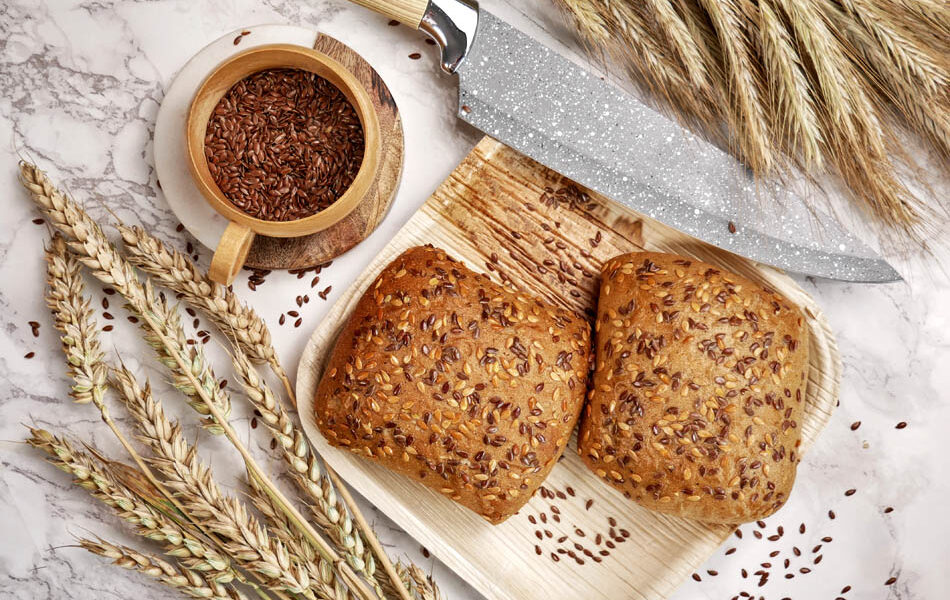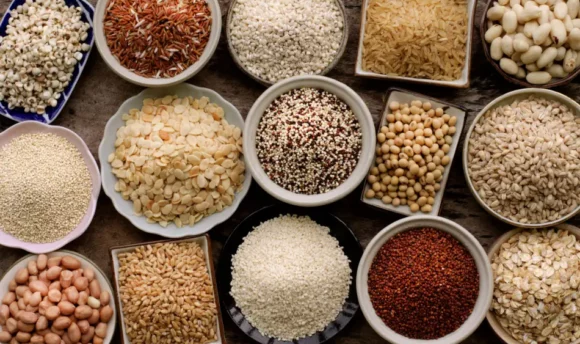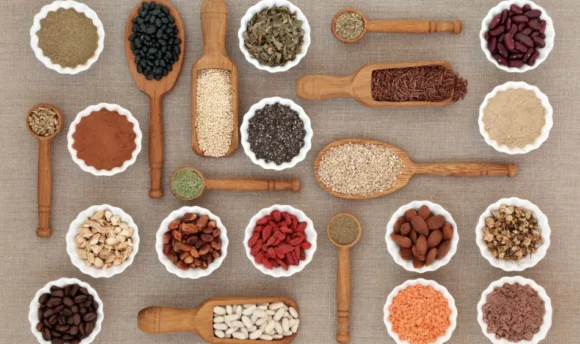Is Multigrain Bread Healthy? Nutrition, Calories
Not all bread has nutritional benefits that improve your diet. That doesn’t mean there aren’t top contenders. Multigrain bread is packed with valuable nutrients, but does that make it healthy? We explain if this bread can strengthen your meals and long-term health.

Bread is a common food that comes in many varieties.
You may have stumbled across multigrain – a type of bread that comprises different grains, like flax seeds, oats, wheat, and whole-wheat flour. Now, this food might seem overwhelming, but it’s actually packed with nutrients that could give you longer-lasting energy.
People often choose multigrain over typical white and brown bread. This is because it rarely contains highly processed wheat flour or added sugars. So, does the huge ingredients list make multigrain bread unhealthy, or can you have it with some delicious meals?
In this article, you’ll discover if multigrain bread is good for your diet.
Is Multigrain Bread Healthy?
Yes, multigrain bread is healthy, but only if the bread is completely whole-grain. Foods containing whole grains usually have a better source of fiber, magnesium, iron, and B vitamins. Some good examples include oats, bulgur, millet, buckwheat, and barley.
Certain types of bread, like processed white bread, can actually increase the risk of heart disease. However, multigrain bread is a great option for building a healthy diet. It contains a high amount of dietary fiber that prevents serious constipation and maintains good bowel movement.
A handful of essential nutrients can also improve your long-term health. For example, in a loaf of multigrain, there’s selenium, iron, magnesium, and lots more. Magnesium may promote weight loss and reduce blood sugar levels in those who have type 2 diabetes.
If you want to buy fresh multigrain bread, always read the label first. Ones that state it’s 100% whole-grain should go straight into your basket. This is because whole-grain products don’t contain refined grains – a type of ingredient that has been stripped of important nutrients.
3 Benefits of Multigrain Bread
There are many benefits to eating multigrain bread. Of course, with any whole-grain product, you’re bound to feed the body very important minerals. Multiple grains in this bread have their own individual advantages that boost heart, brain, and digestive health.
Let’s take a look at the 3 health benefits of multigrain bread.
#1 Lowers the risk of heart disease
Your heart is fond of three minerals – magnesium, calcium, and potassium.
Getting enough of these on your diet can lower the risk of certain heart diseases. Multigrain bread contains adequate amounts of potassium, which reduces blood pressure and keeps the heart rhythm steady. The same goes for calcium when regulating your heartbeat signals.
You should always choose whole grains over white bread. The refined flour in white bread can contribute to weight gain and diabetes. It also contains chemicals to prolong shelf life. Any type of chemical in foods can increase the risk of coronary artery disease.
#2 Supports healthy digestion
The fiber in multigrain bread can boost digestion. Fiber adds bulk to your stools, which lowers constipation issues. This type of carbohydrate may also feed your gut important bacteria, leading to improved microorganisms that strengthen the gastrointestinal tract.
So, when you’re going down the bread aisle in the grocery store, think about how whole grains prevent uncomfortable bowel movements. There’s nothing worse than experiencing headaches and back pain from constipation, especially if your diet doesn’t contain fiber-rich foods.
#3 Reduces blood sugar levels
Certain nutrients like magnesium and dietary fiber can reduce blood sugar. This is especially good for people who have type 2 diabetes. The high amount of fiber can slow the absorption of sugar after big meals, meaning you won’t get those blood glucose or blood pressure spikes.
Reduced blood sugar also means you aren’t at risk of kidney disease, nerve damage, or vision problems. Whole-grain bread, like multigrain, has a lower glycemic index compared to other grain bread. Low-GI foods hugely benefit type 2 diabetes and hypertension management.
What Are the Differences Between Multigrain and Whole-Grain Bread?
There are many similarities between multigrain and whole-grain bread, but there are ways to establish the difference. Multigrain usually contains several types of grains in just one slice. Whole-grain products have 100% unrefined ingredients during the milling process.
Sometimes, it might be hard to determine the unique qualities of each bread. For example, multigrain has a few healthy grains, but they might not always be whole. This could be white flour, flax seeds, chia, and other forms of refined flour that don’t contain essential nutrients.
Whole grain only has three edible layers that have been carefully made to retain dietary fibers and vitamins. Those layers include bran, the endosperm, and the germ. Not all multigrain bread has these important ingredients, so always check the label before buying it at the store.
Nutrition Facts
Here are some amazing facts about multigrain bread:
- Barley is a common grain in this bread, as it contributes to the high-fiber content.
- There are seven-grain and nine-grain bread you can buy. The nine-grain versions usually contain more seeds like flax, sunflower, quinoa, and pumpkin.
- Multigrain bread is in the top 5 pieces of bread to have for managing diabetes, including rye bread. This is because it contains dietary fiber, magnesium, and protein.
- The fiber in most whole grains is four times greater than those in white bread.
- Multigrain (whole-grain) bread especially holds more vitamins compared to regular bread that only uses enriched flour. Vitamins C, B6, and K are great at boosting your long-term health. People with diabetes need these vitamins to reduce blood sugar levels.
Nutrition table (per 100g)
Below, you’ll find the nutritional value of whole-grain multigrain bread per 100g:
| Calories/Nutrient (per 100g) | Amount |
| Calories (kcal) | 265 |
| Sodium (mg) | 381 |
| Net Carbs (g) | 35.9 |
| Fiber (g) | 7.4 |
| Sugar (g) | 6.39 |
| Fats (Total) | 4.23 |
| Protein (g) | 13.4 |
| Cholesterol (mg) | 0 |
High in carbohydrates
There are 35.9 grams of net carbohydrates in multigrain bread. This amount might seem like a lot, but they are your main source of energy. Not getting enough carbs means you’ll start to feel weak and experience symptoms like headaches, tiredness, and frequent muscle cramps.
Whole-wheat or whole-grain bread typically holds onto more complex carbs. Many of those carbs retain things like protein, fiber, and certain fats. You shouldn’t feel put off by the high-carb content unless you’re planning to follow a low-carb meal plan like the ketogenic diet.
Moderate amount of calories
Calories might be important to those who are losing weight. Whole-grain bread containing all the grains will have more calories due to the carbohydrates, fats, sugars, and protein. There are only 265 calories per serving of multigrain, so you can eat it with lunch or even dinner.
Just remember that eating too many whole grains could exceed the daily calorie intake. Of course, the whole-grain or whole-wheat bread is delicious, but you can go overboard. This might result in future weight gain or an increased risk of developing coronary artery diseases.
High in protein
Consuming lots of protein may reduce your appetite and increase muscle mass. This is especially great for people who want to start weight training. Any type of whole-wheat bread with whole grains can give you the right amount of energy to work out and lose fat.
However, too much protein has the chance to cause constipation. Multigrain bread has 13.4 grams of protein, so always monitor how much you’re eating. It’s recommended that people get at least 50–60 grams of protein a day to fuel muscle growth and maintain good organ function.
High in vitamins and minerals
Of course, any type of multigrain whole-wheat bread will have essential minerals. This is because the whole-grain kernel has bran, germ, and endosperm – layers that retain nutrients. Some of these nutrients include B vitamins, iron, copper, phytochemicals, zinc, and magnesium.
B vitamins are especially great for strengthening the metabolism. A fast metabolism encourages the body to burn more calories during the day. Your average white bread doesn’t contain any of these vitamins, so always opt for multigrain that is made using whole grains or whole wheat.
Homemade Multigrain Bread Recipe
Making your own multigrain bread recipe might be better than buying it from the store. Some companies often add preservatives that aren’t good for your health. You can control what ingredients go into the bread while ensuring the recipe only uses whole grains.
Below, you’ll find a simple homemade multigrain recipe:
Ingredients:
- Whole-wheat flour (250g)
- Spelt flour (250g)
- Fresh or dried yeast (10g)
- Mixed spices (1.5 tablespoons)
- Your choice of whole grains (3 tablespoons)
- 11fl oz lukewarm water
How to prepare
- Soak the whole grains in one cup of water to soften them. This prevents the grain from burning while you bake the bread in the oven.
- Combine the whole wheat and spelt flour in a large bowl. During this time, also add the mixed spices, which could be cumin, oregano, paprika, and thyme.
- Dissolve the fresh yeast in some lukewarm water. The water should be around 110ºF/43ºC to avoid killing the yeast and ruining your dough.
- Then, combine the flour mixture and yeast. Keep mixing this until it forms a dough.
- Take out the dough, roll it onto some whole-wheat flour, and knead the dough for 10–15 minutes. The texture should feel soft and elastic after a while.
- Roll the dough into a large bowl and drizzle some olive oil around the surface. Add that to another large clean bowl, cover it with a damp tea towel, and leave it to set for one hour.
- Remove the dough after 60 minutes and shape it into your desired loaf.
- Prepare your chosen baking tin by lining it with baking paper. Then, you can add the dough to the tin and drizzle your soaked whole grains.
- Cover your dough again with a damp towel and leave it for 45 minutes. This should double in size during that time, but don’t leave it any longer.
- When the dough is proofing, preheat the oven to 480ºF/250ºC.
- Place one tray in the bottom of the oven to store some water, as this helps to keep the environment moist and warm for the bread.
- Once it has been 45 minutes, put your dough into the oven and add water to the bottom tray.
- Bake the dough for 15–20 minutes. To check it’s fully done, use a thermometer and see if it reads between 190–200ºF/~90ºC.
- Make sure to let the bread cool down before cutting it.
Nutritional value of multigrain bread recipe
| Nutrient (per serving) | Amount |
| Calories (kcal) | 285 |
| Total fat (g) | 2 |
| Net Carbohydrates (g) | 51 |
| Sugars (g) | 1 |
| Fiber (g) | 9 |
| Protein (g) | 11 |
| Sodium (mg) | 777 |
FAQs
Multigrain bread is only good for you when it is whole-grain. If the bread doesn’t contain natural whole grains, it might increase the risk of weight gain or cardiovascular diseases. You can also look for healthy bread that has the “100% whole wheat” label to get the same nutrients.
Yes, some multigrain bread could have nuts, depending on the brand. You should check the ingredients label before buying the product, especially if you have a nut allergy. However, most bread only has seeds like chia, sunflower, or flax, so it might be safe to have in your diet.
A Word From Our Nutritionist
Multigrain bread is only healthy if it contains whole wheat and wheat flour. Products with refined flour may not have the right amount of nutrients. For example, white bread is made using chemicals, preservatives, and additives, which increase the risk of cardiovascular disease.
Remember that whole-wheat bread can have different grains. You need to make sure they’re all whole, even after the milling process. You could make your own bread using wheat flour, oats, barley, buckwheat, and a range of unique spices that enhance the flavor of your loaf.
Some people may think whole-wheat bread is bland, but it’s better than feeding your body refined carbohydrates. There’s a chance to add your own flavor and pair it with healthy spreads. For example, you could smother crushed avocado with pepper on top of whole-wheat bread.
Conclusion
So, you’re walking down the bread aisle and spot multigrain bread, but is it truly healthy?
You can definitely incorporate this type of bread into your diet. Whole-wheat or grain products typically retain more nutrients compared to those with white flour. Just make sure to check the ingredients label before buying the bread to avoid eating highly processed seeds.

















































 Select your language:
Select your language: 








